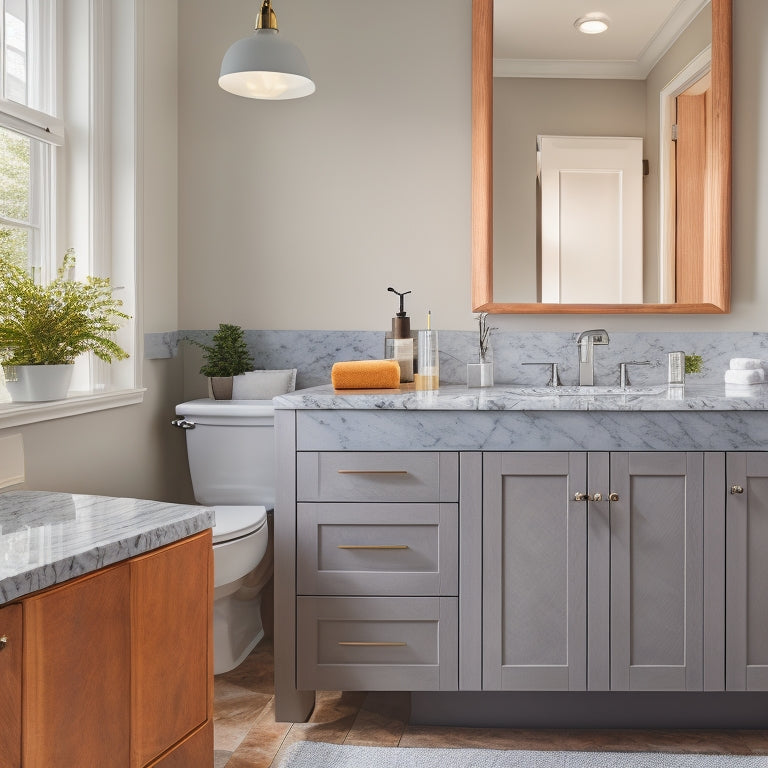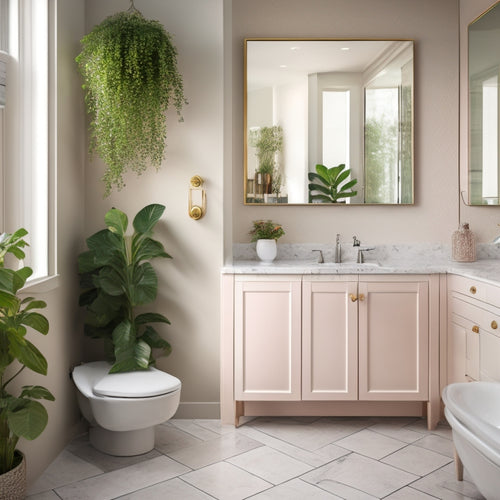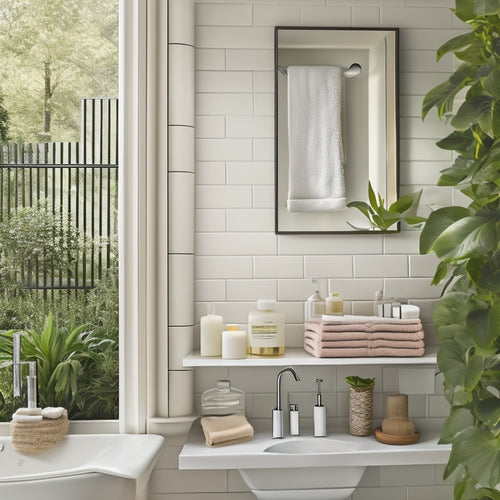
Build Your Own Bathroom Vanity
Share
You're about to commence on a rewarding expedition to create a personalized bathroom oasis by building your own vanity. Start by determining the success factors of your project, including bathroom dimensions, personal style, and budget. Measure the space accurately, noting obstructions and unique features, and define your personal style - modern, traditional, or a mix. Plan storage solutions, such as cabinets with drawers or shelves, and consider your daily routine needs to guarantee easy access to essentials. With these details in mind, you'll be well on your way to crafting a vanity that's both functional and stylish - and there's more to come if you keep going.
Key Takeaways
- Determine your bathroom's unique dimensions, personal style, and budget to plan a custom vanity that meets your needs.
- Choose high-quality, durable materials that can withstand humidity, such as solid surface, stone, or laminate for the vanity top.
- Consider storage solutions, like cabinets with drawers or shelves, to ensure easy access to essentials and maintain a clutter-free space.
- Take precise measurements and employ accurate cutting techniques to build the frame, and assemble the cabinet structure with durability in mind.
- Select the right adhesive for your chosen materials, prepare surfaces thoroughly, and apply adhesive evenly to ensure a strong, long-lasting bond.
Planning Your Bathroom Vanity
Planning Your Bathroom Vanity
Three essential factors will determine the success of your bathroom vanity project: your bathroom's dimensions, your personal style, and your budget. Don't even think about picking up a hammer until you've got these three elements dialed in.
Measure your bathroom space carefully, taking note of any obstructions or quirks that might impact your design. Next, think about your personal style - do you lean modern and sleek or traditional and ornate? This will help you narrow down your design inspiration and make decisions about things like sink shape and faucet style.
Now, let's talk storage solutions. You'll need to plan for where you'll stash your toothbrush, toothpaste, and other essentials. Will you opt for a cabinet with drawers, shelves, or a combination of both?
Consider your daily routine and what you need to have within easy reach. By thinking through these details, you'll be able to create a functional and beautiful bathroom vanity that meets your needs and reflects your style.
With these essentials in place, you'll be ready to start building your dream vanity.
Choosing the Right Materials
You'll need to select materials that can withstand the humid bathroom environment, so prioritize high-quality options that won't warp, crack, or discolor over time.
Next, consider the vanity top: will you opt for a sleek solid surface, a durable stone, or a budget-friendly laminate?
Material Quality Matters
Craftsmanship starts with the foundation, and in the case of building your own bathroom vanity, that foundation is the materials you choose.
You can't build a sturdy, long-lasting vanity with subpar materials, no matter how skilled you are. So, what makes a material worthy of your bathroom vanity?
Here are some key factors to evaluate:
-
Durability testing: Will the material withstand the humid bathroom environment and constant use?
-
Moisture resistance: Can the material handle the occasional splash or spill without warping or rotting?
-
Aesthetic appeal: Does the material fit your desired style and color scheme?
- Budget-friendliness: Are you willing to splurge on high-end materials or opt for more affordable alternatives?
Vanity Top Options
With your foundation materials selected, it's time to think about the vanity top, a critical component that will be subject to daily wear and tear.
You'll want a surface that's both durable and stylish. The age-old debate rages on: granite vs quartz. Granite, a natural stone, offers unique patterns and a luxurious feel, but it can be pricey and high maintenance.
Quartz, on the other hand, is a more affordable, low-maintenance option that still packs a stylish punch.
When making your decision, consider your budget and lifestyle. If you're looking to splurge, granite might be the way to go. However, if you're on a tighter budget, quartz is a great alternative.
Don't forget to factor in the cost of installation, as this can add up quickly. Additionally, think about your daily routine – if you have a big family or love to cook, you might want a material that's more resistant to stains and scratches.
Whichever you choose, make sure it's one that will make you happy for years to come.
Cabinet Style Variety
As you move on to selecting the cabinet materials, consider the style variety that will define your bathroom's aesthetic.
You've got a blank canvas, and the right choice can make or break the overall look.
-
Modern designs: Sleek, minimalist, and often featuring clean lines, modern cabinets are perfect for those who crave a contemporary vibe. Think high-gloss finishes, bold colors, and an emphasis on functionality.
-
Traditional styles: If you're going for a classic, timeless look, traditional cabinets are the way to go. Expect ornate details, rich wood tones, and a warm, inviting atmosphere.
-
Rustic charm: For a cozy, country-inspired feel, opt for rustic cabinets with distressed finishes, natural materials, and ornate metalwork.
- Intermediate hybrids: Can't decide between modern and traditional? Transitional cabinets blend the best of both worlds, offering a balance of clean lines, ornate details, and versatility.
Measuring and Cutting the Frame
You'll need to take precise measurements of your bathroom to guarantee your vanity frame fits snugly against the wall and accommodates the sink, plumbing, and any other components.
Measure the width of the space where the vanity will sit, taking note of any obstructions like electrical outlets or heating vents. Record the dimensions of the sink, faucet, and any other components you'll be using.
Next, use these measurements to determine your frame dimensions. Make certain to account for the thickness of the vanity top, the height of the sink, and any other features that will affect the frame's size.
Take your time, and double-check your math to avoid costly mistakes.
When it comes to cutting the frame, use precise cutting techniques to guarantee accurate results. A miter saw or circular saw will make quick work of the task.
Cut the frame pieces according to your measurements, using a level to guarantee everything stays square. Don't worry if it takes a few tries to get it right – practice makes perfect!
Assembling the Vanity Cabinet
Now that your frame pieces are cut to size, it's time to bring them together to form the vanity cabinet. This is where your design variations come to life, and with some assembly tips, you'll be on your way to a stunning bathroom feature.
To guarantee a sturdy cabinet, follow these assembly tips:
-
Use the right fasteners: Choose screws or nails that are suitable for the type of wood you're using. Don't skimp on quality – you want your vanity to last.
-
Assemble in sections: Build the sides, top, and bottom separately before combining them. This will make it easier to manage the pieces and avoid errors.
-
Clamp, clamp, clamp: Use bar clamps or F-style clamps to hold the pieces together while you attach them. This will prevent the wood from shifting and guarantee a snug fit.
- Measure twice, attach once: Double-check your measurements before attaching the pieces. A small mistake can throw off the entire assembly.
Installing the Countertop
You'll need to take precise measurements of your vanity cabinet to guarantee a seamless fit with your countertop.
Measure the cabinet's width, length, and any obstructions, such as plumbing fixtures or electrical outlets, to determine the correct countertop size.
Countertop Measurement Tips
Most bathroom vanities require a custom-fit countertop, and accurate measurements are essential to achieving a seamless installation. To guarantee a perfect fit, you'll need to take precise measurements of your vanity cabinet and the space where the countertop will sit.
Here are some tips to keep in mind when taking measurements:
-
Use the right tools: Invest in a good quality tape measure, level, and square to guarantee accurate readings.
-
Measure multiple times: Take multiple measurements to account for any slight variations in the cabinet or countertop.
-
Consider countertop styles: Different countertop styles, such as undermount or vessel sinks, require different measurements. Make sure to factor these in when taking your measurements.
- Account for cutouts: If your design includes cutouts for sinks, faucets, or other fixtures, make sure to measure these accurately to guarantee a proper fit.
Secure Countertop Attachment
With your precise measurements in hand, you're ready to secure your countertop attachment. This is where the magic happens – or, you know, where the countertop stays put and doesn't end up on the floor.
To guarantee countertop stability, you'll need to choose the right adhesive for the job. Here are some factors to take into account:
| Adhesive Type | Best For |
|---|---|
| Epoxy-based | Granite, marble, or other natural stone |
| Acrylic-based | Laminate, solid surface, or engineered stone |
| Silicone-based | Glass or metal countertops |
| Polyurethane-based | Wood or bamboo countertops |
| Hybrid-based | Most countertop materials, including stone and solid surface |
When selecting an adhesive, make certain to read the instructions carefully and follow the manufacturer's recommendations. You'll also want to prepare the surface by cleaning and drying it thoroughly before applying the adhesive. Finally, apply even pressure to guarantee a strong bond. With the right adhesive and a little patience, your countertop will be secure and ready for its debut.
Adding Finishing Touches
The final stages of your bathroom vanity project are in sight, and it's time to focus on adding those all-important finishing touches.
You've made it this far, and the end result is going to be totally worth it. Now, let's get down to business and add some serious style to your vanity.
To take your vanity from bare bones to beautiful, consider the following finishing touches:
-
Hardware selection: Choose knobs or handles that complement your vanity's style and your bathroom's overall aesthetic. Don't settle for boring – go for something that adds a touch of personality to your space.
-
Decorative accents: Add some visual interest with decorative trim, molding, or even a statement light fixture. These small details can make a big impact on the overall look of your vanity.
-
Install a mirror that's both functional and stylish – after all, this is where you'll be getting ready for your day.
- Add some greenery or a decorative vase to bring in a touch of warmth and personality to your bathroom oasis.
Frequently Asked Questions
Can I Use a Bathroom Vanity Without a Backsplash?
You can definitely skip the backsplash, but consider the design options and functionality considerations - will water splashing from the sink create a mess, or will you install a protective barrier to keep things tidy?
How Do I Protect My Vanity From Moisture Damage?
Imagine water droplets sneaking up on your vanity like sneaky little thieves! You can outsmart them by using moisture-resistant materials, sealing gaps, and following vanity maintenance tips like regular cleaning and drying to keep your vanity safe from moisture damage.
Are Custom Vanity Sizes More Expensive Than Standard Ones?
You're wondering if custom vanity sizes break the bank? Well, they usually do, but the benefits are worth it - you get a perfect fit, while standard ones can leave awkward gaps, making them look, well, kinda lazy.
Can I Add Electrical Outlets to My Bathroom Vanity?
You're renovating your bathroom and wonder if you can add outlets to your vanity. Take the case of Sarah, who installed a USB outlet near her sink for convenient phone charging. You can do it too, just make sure outlet placement is safe and wiring is done by a pro to avoid electrical shock!
Is It Possible to Build a Floating Bathroom Vanity?
You're wondering if you can create a floating bathroom vanity that defies gravity? Yes, it's possible! Choose the right floating vanity design and materials, like wall-mounted cabinets and sturdy brackets, to make it happen.
Conclusion
You've finally built your own bathroom vanity, and it's a work of art! Like a perfectly placed puzzle piece, all the components fit together seamlessly. Now, step back and admire your handiwork - the fruits of your labor are ripe for the picking. Your new vanity is not only functional but also a stunning addition to your bathroom. With these DIY skills, you'll be tackling the next project in no time!
Related Posts
-

Stylish Corner Cabinet Ideas for Bathrooms
Looking to enhance your bathroom with stylish corner cabinets? You can maximize space and improve aesthetics at the s...
-

Creative Open Shelving for Bathroom Displays
You're looking to change your bathroom into a serene oasis, and creative open shelving is the perfect way to showcase...
-

Revolutionizing Mimosa Bars With Creative Printables
Revolutionize your mimosa bar with creative printables that take the experience to the next level. Elevate the setup ...


